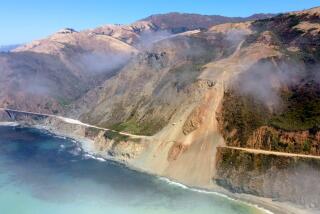Improvements to Coronado Bridge Will Further Clog Sluggish Automotive Artery
- Share via
In what promises to be the longest case ever of lane closure on the San Diego-Coronado Bay Bridge, Caltrans plans to shut down as many as three lanes at a time once a major resurfacing project begins shortly after Christmas.
Contractors are scheduled to begin Dec. 28--a Monday--on at least three months of work to resurface part of the bridge and then install an unusual movable center barrier.
The bridge, which was built in 1969, has never been resurfaced, and Caltrans has been searching for years to find a movable center barrier that will help prevent head-on collisions, according to Caltrans spokesman Jim Larson. Between 1981 and 1991, there were 591 accidents--including 28 head-on collisions--on the bridge that resulted in 360 injuries and eight deaths.
Today, movable cones are used to mark off opposing traffic lanes. Throughout most of the day and night, only four of the bridge’s five lanes are in operation, leaving the center lane as a buffer between traffic. During commute hours the buffer lane is opened.
The movable barrier, which when installed will be able to shift over one lane in either direction from the center of the bridge, will be used to create an additional lane each morning and afternoon to compensate for the prevailing direction of traffic.
As the construction project begins, Caltrans will shut down three of the bridge’s five lanes between the hours of 6 p.m. and 5 a.m. on weekdays and during daylight hours on weekends. Though only one lane will be torn up and then resurfaced at a time, two more lanes must be closed while work is in progress in order to allow space for workers and their equipment.
The plan now is to remove the equipment and halt work during the commute in the morning and afternoon, leaving four lanes--one lane less than usual--open during peak commute hours.
For the morning commute during construction, Larson said, three lanes will be open to traffic headed for Coronado. But because traffic patterns change in the evening, those same commuters will only have two lanes to cross the bridge to reach San Diego in the evening. Closure of just that one lane is expected to cause severe traffic congestion, Larson said.
In 1991 an average of 63,370 vehicles crossed the bridge daily.
To compensate for the lane closure, Caltrans officials are stressing a series of alternative modes of transportation, including use of ride sharing, buses and the Coronado ferry. They are not advocating that motorists try to avoid the bridge by driving along Silver Strand Highway, which is near capacity now at peak hours, Larson said.
Next week, Larson said, motorists will be given fliers at the bridge’s toll booth that will explain several ways drivers can avoid long backups while work on the bridge is under way. Among the alternatives that Caltrans suggests:
* Passenger ferry service will be implemented during the peak travel periods.
* A $15 subsidy toward purchase of a monthly transit pass.
* Bolstered transit service to and from Coronado.
* A $15-a-month van pool subsidy for van riders.
Caltrans is also encouraging commuters and their employers to implement flex time and telecommuting.
Construction on the bridge should be completed by early March, Larson said, though it could take longer depending on temperatures--some of the materials used in resurfacing the bridge need heat to dry--and rainfall, which could delay work.
Workers will resurface an 1,800-foot section of the bridge’s middle spans. Included in that $2 million project will be installation of a guide wire in the pavement.
That guide wire will be used to direct a vehicle that will move the new barrier over one lane each morning and afternoon. The movable barrier--a series of concrete segments--and the vehicle that will move it cost about $2.5 million, Larson said. All the work is being funded with state toll-bridge funds.
More to Read
Sign up for Essential California
The most important California stories and recommendations in your inbox every morning.
You may occasionally receive promotional content from the Los Angeles Times.










